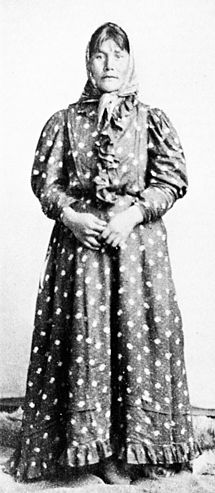it gray to any extent. A bald-headed Indian would have been looked upon as a phenomenon.
I saw two Indians last summer whose ages were given by their people as one hundred and twenty and one hundred and thirty years. Old settlers who have known of them for fifty years do not think the figures are much exaggerated. The wrinkles in their faces were so deep that the skin fell in folds, and their bodies seemed to have shrunken to one half their former size. They were deaf, dumb, blind, bent, and helpless, yet their hair was A "Digger" Mahala from Feather River, Full-blooded, and of Finer Physique than the Average.barely streaked with gray, and so thick that a comb of ordinary size could not be passed through it.
A "Digger" Mahala from Feather River, Full-blooded, and of Finer Physique than the Average.barely streaked with gray, and so thick that a comb of ordinary size could not be passed through it.
The manners and customs of these Indians differed but little from village to village. During the summer months they needed only a shade to protect them from the hot sun. The wild, free life in which they reveled at this time of the year needed only food, but as winter drew near they had to build something which would protect them from the severe storms. An excavation several feet deep, and varying in diameter, was made first. Around the edge of this, willow poles or small trees were placed upright in the ground and drawn together at the top until a cone-shaped structure was formed. Bushes and strips of bark were then woven closely about this; lastly, dirt was thrown on and packed solid to the depth of six or eight inches. Only two openings were left—a round one at the top for the escape of smoke, and a square one close to the ground on the side most sheltered from the wind, which was used for a door; this opening was made just large enough for the occupants to crawl through. Furs and strips of matting woven from tule grass were used to sleep on. A fire was kept burning day and night in the middle of the "campoodie" (Kahm-Poo-Dy), the Indian name for these houses.
